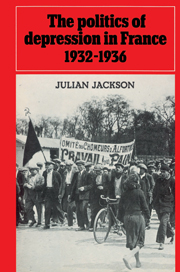Epilogue: The politics of rearmament 1936–1939
Published online by Cambridge University Press: 02 November 2009
Summary
The elections of 1936
The government of Albert Sarraut which replaced Laval was on the left in spite of itself. It was a government of left concentration – stretching from the U.S.R. on the left to the Républicans de Gauche on the right–with a Popular Front majority: the Socialists voted for it, the Communists abstained for the first time and the Centre Républicain voted against, in spite of the continued presence in the Cabinet of such figures as Régnier and Laval. The government's main role was to effect a transition between Laval and the elections. And like most governments of this kind it would no doubt have been forgotten by history had it not suffered the cruel fate of presiding helplessly over the re-occupation of the Rhineland in March 1936.
In the field of economic policy it performed the necessary holding operation. Régnier, who remained Minister of Finance and arch opponent of devaluation, found himself in the same Cabinet as Déat, himself in favour of devaluation. The beginning of the new financial year was difficult for any government, and the financial problems that Baumgartner had predicted quickly materialized. At the end of February the government borrowed 3m on the London market. The Rhineland crisis increased nervousness, and a number of Treasury Bills were traded in. But the last act of the Chamber was to accept, at the end of March, what it had previously refused in December, that the Fonds d'outillage of the 1936 budget could be funded by short-term loans.
- Type
- Chapter
- Information
- The Politics of Depression in France 1932–1936 , pp. 200 - 211Publisher: Cambridge University PressPrint publication year: 1985
- 1
- Cited by



